Wai-Fah Chen.The Civil Engineering Handbook
Подождите немного. Документ загружается.

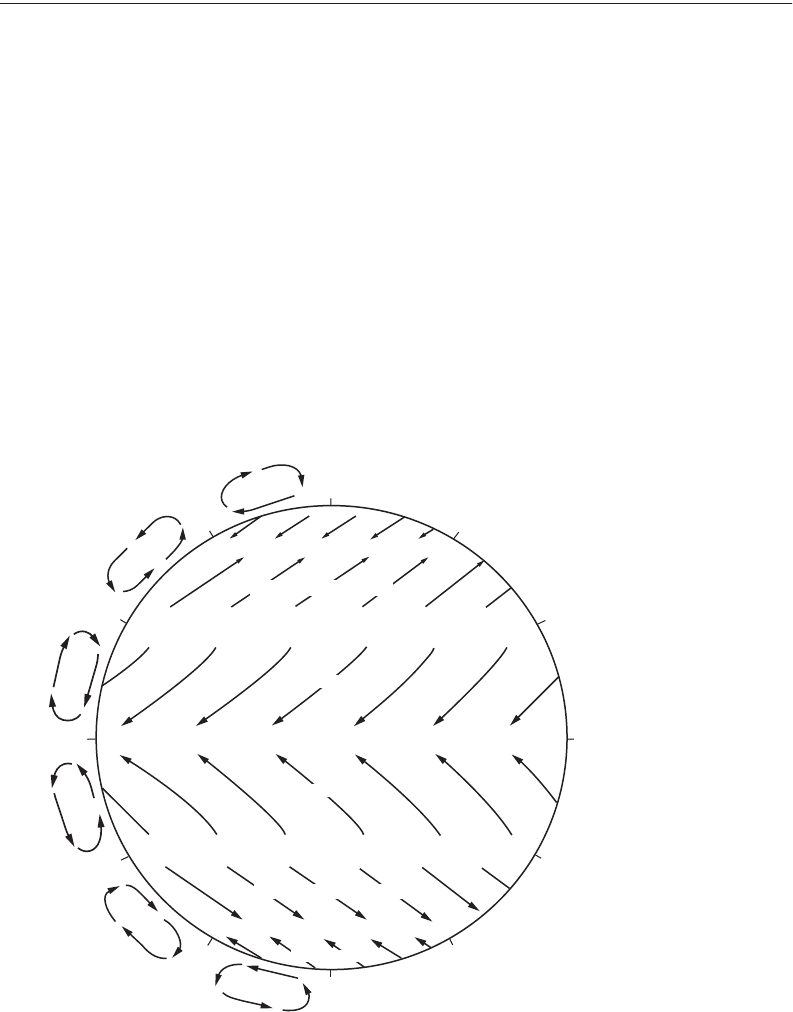
12-50 The Civil Engineering Handbook, Second Edition
incineration is a method to lower operating temperatures and thus lower operating costs; however, catalyst
poisoning is a significant problem. Both types of incineration offer the most effective means of odor
control, but do so at the highest capital and operating costs.
12.7 Air Pollution Meteorology
After an emission source has been characterized as to type and size, the question arises as to how the
source and the resulting emissions will affect the quality of the downwind ambient air. This determination
requires that the source further be described by modeling, or the estimation of the atmospheric dispersion
of the various components of the gas stream. The modeling step is often what determines an appropriate
emission rate.
Once the gas stream is emitted into the atmosphere, a complex series of events begins to unfold. The
components (or pollutants) in the gas stream join the environment and are transported, dispersed, and
eventually removed from the atmosphere according to the physical nature of the component. However,
before examining the dispersion of the gas stream, a basic understanding of the environment which
governs the dispersion is required.
Wind (Advection)
The atmosphere is an ocean of air that is in continual motion primarily as a result of solar heating and
the rotation of the earth. As the sun heats different parcels of air in different areas, the heated air responds
by expanding and increasing in pressure. Subsequently, differential pressure areas arise and result in large-
scale air motions, or winds. This is illustrated on a global basis by the large-scale winds created as a result
of differential heating between the equator and the poles. Figure 12.13 illustrates the various winds that
FIGURE 12.13 General global air circulation. (Source: Cooper, C. D. and Alley, F. C. 1990. Air Pollution Control: A
Design Approach. Waveland Press, Prospect Heights, IL. Reprinted by permission of Waveland Press, Inc. All rights
reserved.)
N
60°
30°
30°
60°
S
60° Subpolar lows
30° Horse latitudes
30° Horse latitudes
60° Subpolar lows
0° Equatorial doldrums
0°
Stormy, variable
Stormy, variable
Prevailing westerlies
Prevailing westerlies
Calm or light variable
Calm or light variable
Trade winds
Trade winds
Calm or light
Easterlies
© 2003 by CRC Press LLC
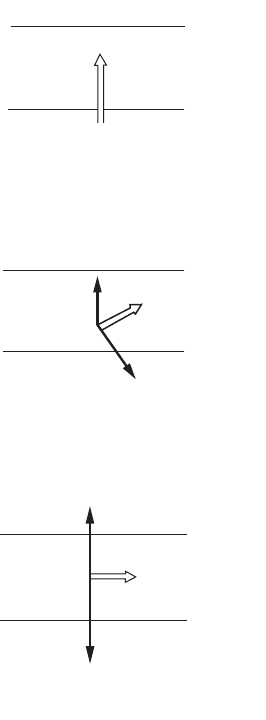
Air Pollution 12-51
would be created by differential heating on a global scale if the earth were smooth and of homogenous
composition [Cooper and Alley, 1990].
Wind Variations
As described previously, movement of air (or wind) is a result of the pressure gradient created by high-
and low-pressure regions interacting. This pressure gradient results in a force, F
p
, that creates a velocity
vector from the high-pressure region to the low-pressure region and, ideally, is perpendicular to both
pressure regions or isobars. This is shown in Fig. 12.14(a), where V is the velocity vector or wind created
by the pressure gradient force.
However, as the earth is rotating the effects of the Coriolis force, F
Cor
, are realized on the movement
of air as well. These forces result in the deflection of the wind from the ideal perpendicular gradient. In
the northern hemisphere, these forces deflect the wind to the right, relative to the surface, while in the
southern hemisphere the force deflects the wind to the left. The magnitude of the Coriolis force is a
function of the velocity of the air, latitude, and the earth’s rotational speed. These forces are at a maximum
at the poles and zero at the equator [Wark and Warner, 1981]. When the pressure gradient and Coriolis
forces are combined, the result, depicted in Fig. 12.14(b), is a velocity vector whose angle is a function
FIGURE 12.14 Effects of various forces on wind direction relative to pressure isobars. (a) Pressure gradient force
only. (b) Pressure gradient force with Coriolis force. (c) Balanced pressure gradient and Coriolis forces. (Source:
Wark, K. and Warner, C. F. 1981. Air Pollution, Its Origin and Control. Harper & Row, New York. Used by permission.)
Low-pressure region
1000 mbar
V
1005 mbar
High-pressure region
(a)
Low-pressure region
1000 mbar
V
1005 mbar
F
p
F
Cor
High-pressure region
(b)
Low-pressure region
F
p
V
g
F
Cor
High-pressure region
(c)
© 2003 by CRC Press LLC
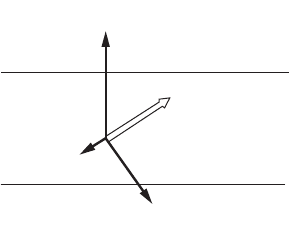
12-52 The Civil Engineering Handbook, Second Edition
of the relative magnitude of the two forces to each other. In the ideal case, the pressure gradient and
Coriolis forces are balanced such that the resultant velocity vector is parallel to the isobars. This is depicted
in Fig. 12.14(c). The resulting wind always moves such that the pressure gradient force is in the direction
of the low-pressure region and is balanced by the Coriolis force in the direction of the high-pressure
region. The corresponding velocity vector is at a right angle to both. Movement of the wind is to the
right of the Coriolis force and is therefore moving such that the low-pressure region is to the left of the
vector. This idealized wind is referred to as the geostrophic wind and approximates conditions a few
hundred meters above the earth’s surface [Wark and Warner, 1981].
While the geostrophic wind is associated with parallel isobars, the gradient wind is associated with
curved isobars. The gradient wind differs from the geostrophic wind by the centripetal acceleration, a
c
,
associated with the movement of a parcel of air in a curvilinear motion. The gradient wind is evident
around centers of high and low pressure [Wark and Warner, 1981].
Winds at the earth’s surface are further complicated by the fact that the earth is not smooth and
homogenous. As a result several other factors need to be considered when discussing the magnitude and
direction of the wind. Among these are [Cooper and Alley, 1990]:
1. Topography
2. Diurnal and seasonal variation in surface heating.
3. Variation in surface heating from the presence of ground cover and large bodies of water
Principal among these factors is the frictional force, F
f
, arising from surface roughness or the effect of
the earth’s topography. Additionally, variation in heating arises from daily and seasonal changes that
affect the movement of air on a local basis. Both of the factors are combined as surface heating is a
function of incoming solar radiation and the local surface characteristics.
The region of the atmosphere between the earth’s surface
and the upper reaches of the atmosphere is referred to as the
planetary boundary layer [Wark and Warner, 1981]. In this
layer, all of the factors mentioned above result in this frictional
force that combines with the pressure and Coriolis force to
alter the direction and magnitude of the wind at a slight angle
toward the low-pressure region. This is illustrated in Fig. 12.15.
The frictional force acts opposite to the direction of the veloc-
ity vector, which in turn acts at a right angle to the Coriolis
force. The resulting magnitude of the wind velocity is the sum
of the components of the individual force vectors, with the
direction being at a slight angle toward the low-pressure
region. This surface wind is of a magnitude less than the geo-
strophic wind.
The combination of the pressure gradient, Coriolis, centrip-
etal acceleration, and frictional forces is determined in the
clockwise and counterclockwise flow around high- and low-
pressure systems, respectively. This pattern of flow is shown
in Fig. 12.16.
Wind Rose
The wind in a specific location varies with the movement of pressure systems and heating patterns and
produces characteristic patterns that can be represented by a statistical diagram called a wind rose [Turner,
1979]. A wind rose is a polar diagram that plots the frequency of the observed direction of a wind as a
spoke. Additionally, the magnitude of the wind from a particular direction is included in the diagram as
the length of the individual segments of the spoke. The observed direction of the wind is the direction
from which the wind is blowing. Figure 12.17 is a wind rose generated from AIRS data for 1992 in
Chicago, Illinois.
FIGURE 12.15 Frictional force effect on
the magnitude and direction of the wind.
(Source: Wark, K. and Warner, C. F. 1981.
Air Pollution, Its Origin and Control. Harper
& Row, New York. Used by permission.)
Low-pressure region
High-pressure region
F
f
v
F
p
F
Cor
© 2003 by CRC Press LLC
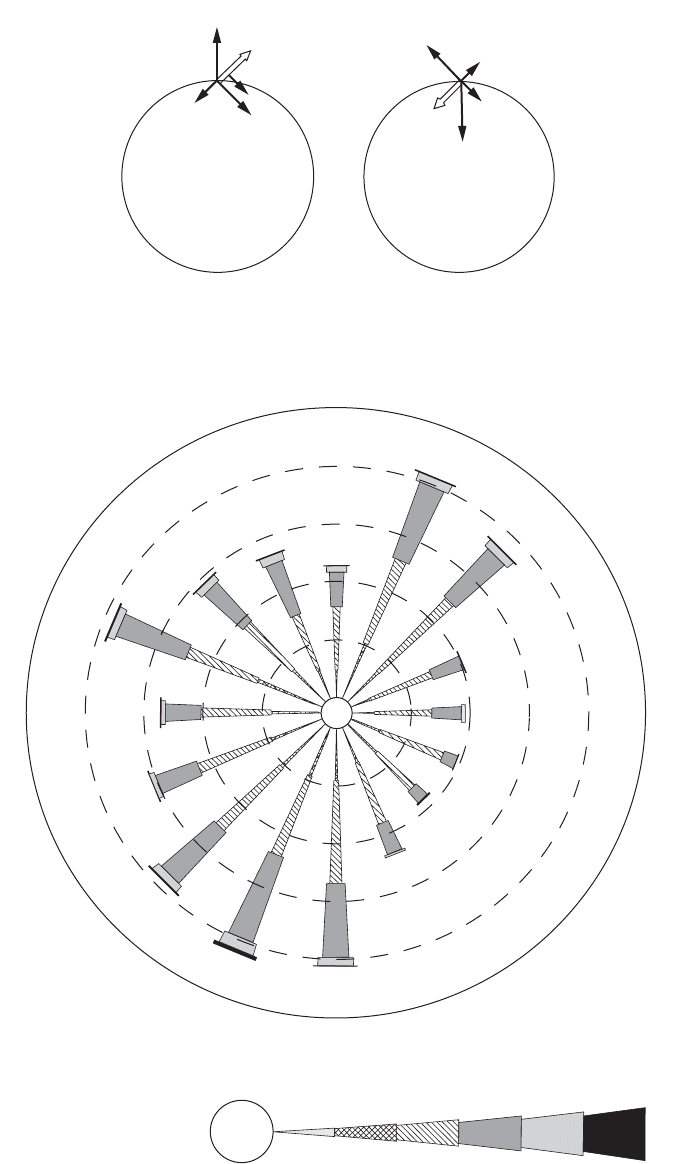
Air Pollution 12-53
FIGURE 12.16 Force balances around (a) a high-pressure region, and (b) a low-pressure region. (Source: Wark, K.
and Warner, C. F. 1981. Air Pollution, Its Origin and Control. Harper & Row, New York. Used by permission.)
FIGURE 12.17 1992 wind rose, Chicago, Illinois.
High-pressure region
Low-pressure region
High-pressure region
Low-pressure region
F
p
V
F
f
a
c
F
Cor
F
Cor
F
f
V
a
c
F
p
January 1-December 31; Midnight-11 PM
N
E
S
W
WIND SPEED (KNOTS)
CALM WINDS 4.41
%
NOTE: Frequencies
indicate direction
from which the
wind is blowing.
CALMS
1-3
4-6
7-10
11-16
17-21
+
21
2%
4%
6%
8%
10%
© 2003 by CRC Press LLC
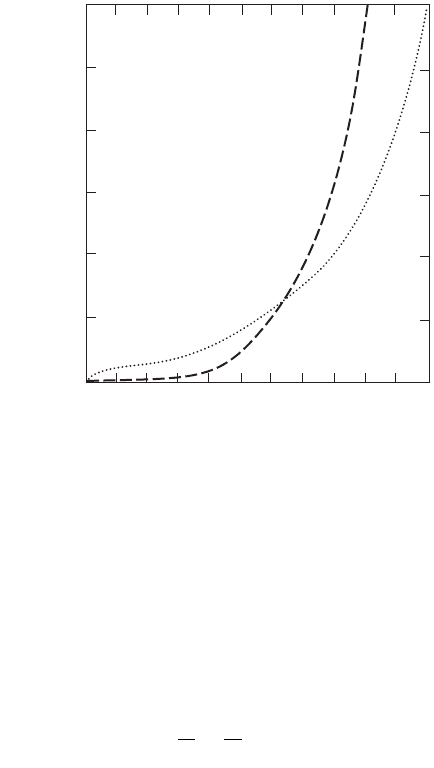
12-54 The Civil Engineering Handbook, Second Edition
Vertical Velocity Profile
When all of the factors influencing the magnitude and direction combine, the resulting wind is found
to vary in magnitude with elevation above the earth’s surface. In the lower reaches of the atmosphere
the magnitude of the wind is retarded by the frictional forces, but as elevation increases the frictional
forces diminish and the magnitude of the wind increases. This relationship is described as the vertical
velocity profile of the wind, and can be approximated numerically by
(12.43)
where u is the wind velocity at an elevation of z, u
1
is the wind velocity at an altitude of z
1
, and p is a
constant based on the stability of the atmosphere. The constant p ranges from 0 to 1. Figures 12.18 and
12.19 demonstrate the effects of the local surface characteristics and atmospheric stability on the vertical
velocity profile of the wind.
Stability
As the wind varies with differential heating, elevation, and surface characteristics, the stability of the
atmosphere, or its ability to enhance or impede vertical motion, also varies [Turner, 1979]. The turbulence
of the lower atmosphere is a function of the vertical temperature gradient, wind speed and direction,
and surface characteristics. Stability can be classified into six categories based on general atmospheric
conditions. These categories, included in Table 12.15, decrease in dispersional ability as the letter desig-
nation increases. Further, actual atmospheric conditions are assigned a stability class by several different
methods, with each method varying in degree of complexity. A general description of the atmospheric
stability, letter designation, and associated vertical velocity profile constant are given in Table 12.16.
Perhaps the method most often used is based on reference to a given vertical temperature gradient a
parcel of air should encounter. The reference gradient is the dry adiabatic lapse rate.
FIGURE 12.18 Diurnal variations in the vertical velocity profile. (Source: Turner, D. B. 1979. Meteorological fun-
damentals. In Recommended Guide for the Prediction of the Dispersion of Airborne Effluents, ed. J. R. Martin. The
American Society of Mechanical Engineers, New York. Used by permission.)
WIND SPEED (m/sec)
01
23
456
7
891011
0
100
200
300
HEIGHT
ABOVE
GROUND(m)
400
500
600
GRADIENT WIND
DAY
NIGHT
"SURFACE" WIND
u
u
z
z
p
11
=
Ê
Ë
Á
ˆ
¯
˜
© 2003 by CRC Press LLC
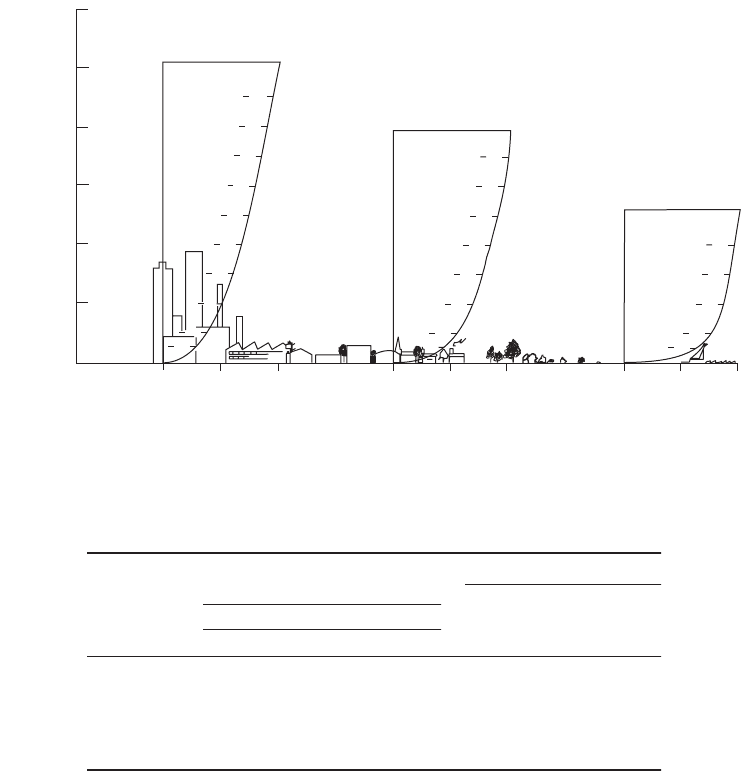
Air Pollution 12-55
Lapse Rates
The dry adiabatic lapse rate is the theoretical rate of cooling that should predict the temperature of a
parcel of air as it rises in the atmosphere. This rate is derived by the situation that when a parcel of air
rises in the atmosphere it expands and cools as the surrounding pressure decreases. If the parcel is assumed
to expand and cool under adiabatic conditions (that is, assuming there is no heat exchange with its
surroundings) the parcel of air should cool at a rate of –5.4°F per 1000 feet (–1°C/100 meters) increase
in elevation.
FIGURE 12.19 Ve rtical velocity profile variations as a function of surface characteristics. (Source: Turner, D. B. 1979.
Meteorological fundamentals. In Recommended Guide for the Prediction of the Dispersion of Airborne Effluents, ed. J.
R. Martin. The American Society of Mechanical Engineers, New York. Used by permission.)
TA BLE 12.15
Key to Stability Categories
Surface Wind
at 10 meters
(m/s)
Day
Night
Thinly Overcast or
Low Cloud Cover
(≥ 1/2)
Cloud
(£ 3.8)
Incoming Solar Radiation
c
Strong
a
Moderate Slight
b
<2 A A-B B
2-3 A-B B C E F
3-5 B B-C C D E
5-6 C C-D
d
DD D
>6 C D D D D
a
Strong incoming solar radiation corresponds to a solar altitude greater than 60° with
clear skies.
b
Slight insolation corresponds to a solar altitude from 15° to 35° with clear skies.
c
Incoming radiation that would be strong with clear skies can be expected to be reduced
to moderate with broken (5/8 to 7/8 cloud cover) middle clouds and to slight with broken
low clouds.
d
The neutral class, D, should be assumed for overcast conditions during both the night
and day.
Source: Turner, D. B. 1969. Workbook Atmospheric Dispersion Estimates. U.S. Public
Health Service, Cincinnati, OH.
500
600
400
300
200
100
0
HEIGHT
(m)
URBAN AREA
GRADIENT WIND
94
30
40
90
85
80
75
68
61
51
98
95
90
84
77
68
56
45
95
91
86
78
65
10
50
10
50105
0
WIND SPEED (m/sec)
GRADIENT WIND
GRADIENT WIND
SUBURBS
LEVEL COUNTRY
© 2003 by CRC Press LLC
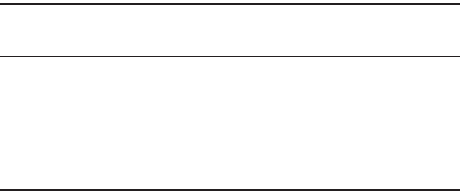
12-56 The Civil Engineering Handbook, Second Edition
Stability Classes
Actual lapse rates in the atmosphere can be determined readily and correspond to atmospheric conditions
at that particular time. There are five general lapse rates found in the atmosphere.
1. Superadiabatic. Shown in Fig. 12.20(a), this condition occurs on days when strong solar heating
is present, and results in a lapse rate greater than –1°C/100 meters. Superadiabatic conditions are
typically found only in the lower 200 meters of the atmosphere and are associated with a stability
class of A, or very unstable conditions.
2. Neutral. This condition is associated with overcast days and strong to moderate wind speeds. The
lapse rate approximates the dry adiabatic lapse rate very closely, as shown in Fig. 12.20(b). Stability
classes associated with neutral conditions are B, C, or D indicating moderately unstable to neutral
conditions.
3. Subadiabatic. This condition is associated with relatively calm days without strong solar heating.
The lapse rate is below the –1°C/100 meters rate, as shown in Fig. 12.20(c). Subadiabatic conditions
correspond to stability classes of D or E for neutral to moderately stable.
4. Isothermal. Shown in Fig. 12.20(d), the temperature in the atmosphere is constant with height,
and as a result, there is no lapse rate. Isothermal conditions coincide with a stability class of D.
5. Inversion. When the temperature gradient increases with height, often found in the evenings on
days with strong solar heating, the condition is referred to as a thermal inversion. This condition
demonstrates extremely stable conditions, with a stability class of F, and results in a positive lapse
rate. This is shown in Fig. 12.20(e).
Plume Characteristics
For each of the atmospheric stability classes listed above, there is a plume type that is characteristic in
both plume shape and downwind concentration. That is, as the gas stream is emitted from the source,
the gas stream (or plume) initially rises and then begins to dissipate in the atmosphere.
Atmospheric stability governs the general characteristics of any plume because the maximum height
the plume rises to, the degree of dissipation, and the downwind distances where the plume constituents
first come into contact with the surface and the distance that the constituents interact with the surface
are all functions of the atmospheric conditions when the plume is emitted. Five general types of plumes
can be visually identified, each generally corresponding to an atmospheric stability class.
The first type of plume is the looping plume associated with great instability in the atmosphere, or a
stability class of A. The name of the plume arises from its shape when viewed from a horizontal
perspective. A looping plume, shown in Fig. 12.21, is characterized by a tortuous shape that finds the
plume rising and falling. This type of plume has a very short downwind initial contact distance with
plume constituents resulting in a gradual concentration profile over a long downwind distance. Strong
TABLE 12.16 Stability Category Descriptions
Velocity Profile
Stability Descriptions
a
Letter Designations
a
Constants (P Values)
Very unstable A 0.12
Moderately unstable B 0.16
Slightly unstable C 0.20
Neutral D 0.25
Moderately stable E 0.30
Ve ry stable F 0.40
a
Source: Tu rner, D. B. 1979. Meteorological fundamentals. In Recom-
mended Guide for the Prediction of the Dispersion of Airborne Effluents,
ed. J. R. Martin, pp. 1–15. The American Society of Mechanical Engi-
neers, New York. Used by permission.
© 2003 by CRC Press LLC
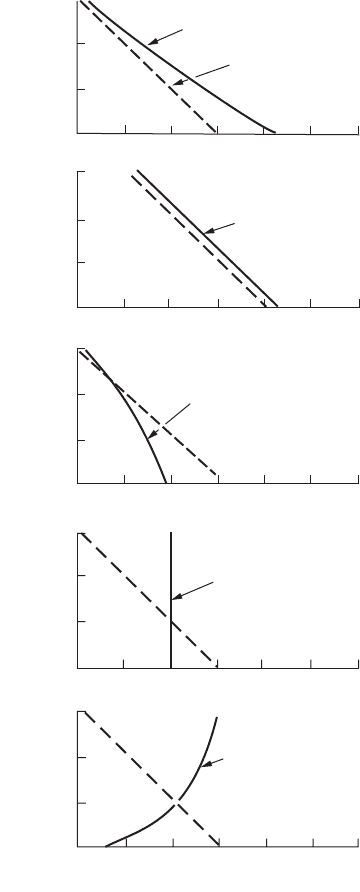
Air Pollution 12-57
instability in the atmosphere creates this situation as the plume is influenced only by great mixing and
no forces preventing surface contact. Additionally, when viewed vertically, the plume meanders a great
distance from its original centerline, and thus has the potential for the plume constituents to affect a
large surface area.
The second type of plume is the coning plume, shown in Fig. 12.22, and corresponds to the near-
neutral conditions or atmospheric conditions in classes B, C, or D. Initially, the plume follows the same
pattern as the looping plume when viewed vertically. However, when viewed horizontally the plume has
FIGURE 12.20 Atmospheric lapse rates in comparison to the dry, adiabatic lapse rate for (a) superadiabatic,
(b) neutral, (c) subadiabatic, (d) isothermal, and (e) inversion conditions. (Source: Turner, D. B. 1979. Meteorological
fundamentals. In Recommended Guide for the Prediction of the Dispersion of Airborne Effluents, ed. J. R. Martin. The
American Society of Mechanical Engineers, New York. Used by permission.)
SUPERADIABATIC
DRY ADIABATIC
LAPSE RATE
100
0
20
21 22
100
0
20 21
22
NEUTRAL
100
0
20
21
22
SUBADIABATIC
HEIGHT
(m)
100
0
19 20 21
ISOTHERMAL
100
0
19 20
INVERSION
TEMPERATURE (°C)
© 2003 by CRC Press LLC
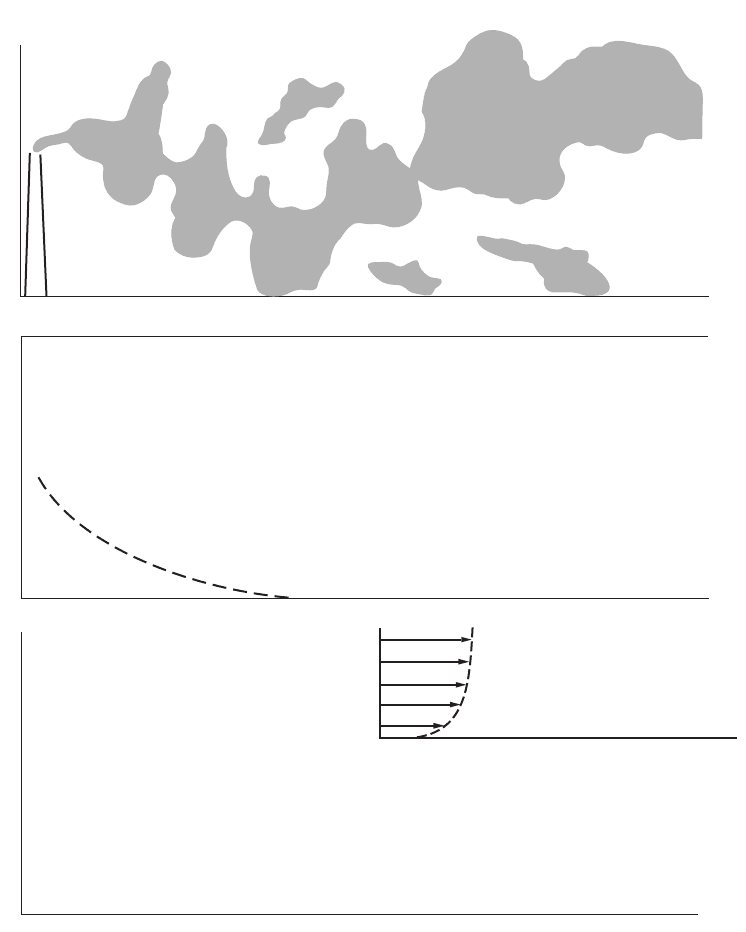
12-58 The Civil Engineering Handbook, Second Edition
a much more gradual pattern of dissipation. This is due to the decreased mixing ability of the atmosphere.
As a result of the decreased mixing, the plume is carried over a much greater distance before its initial
surface contact. Downwind distances these constituents are deposited over are less than the looping
plume, and result in higher surface concentrations of the constituents.
The third type of plume is the fanning plume, the plume type associated with inversion conditions.
These conditions, with a stability class of F, result in the plume being held in a vertical plane by the cooler
air below the stack and the warmer air above it, as is illustrated in Fig. 12.23. As a result, the downwind
FIGURE 12.21 Looping plume. (Source: Pack, D. H. and Halitsky, J. 1979. Behaviour of airborne effluents. In
Recommended Guide for the Prediction of the Dispersion of Airborne Effluents, ed. J. R. Martin. The American Society
of Mechanical Engineers, New York. Used by permission.)
(a)
(a)

12-66 The Civil Engineering Handbook, Second Edition
where Q is the mass emission rate of pollutant (g/s)
u
s
is the wind speed at stack height at the time of emission (m/s)
s
y
is a stability constant described in Table 12.1 (m)
H is the effective stack height (m)
s
z
is a stability constant described in Table 12.1 (m)
For situations which require the consideration of surface reflection, which occurs for most cases, the
double normal Gaussian model of Eq. (12.52) must be used.
(12.52)
The s
y
and s
z
values are borrowed from the Gaussian distribution statistics and are analogized here as
pollutant dispersion variables instead of standard deviations as we usually think of them in a statistical
sense. s
y
is the pollutant dispersion coefficient in the crosswind direction and s
z
is the dispersion
coefficient in the vertical. These dispersion coefficients were originally derived from diffusion experiments
on the O’Neill, Nebraska grass flats following World War II. Since then they have been modified signif-
icantly with experiments in St. Louis, Missouri and elsewhere giving rise to both an urban and a rural
version of the model. The dispersion coefficients can be determined from Table 12.17 for various
downwind distances and atmospheric stability classes [Smith et al., 1979].
It is interesting to note that Eq. (12.52) does not contain a s
x
or downwind dispersion coefficient. The
reason for this is that this model simulates a continuous point source release as opposed to a “puff” or
instantaneous release. The resulting downwind pollutant concentration gradient along a limited segment
of the plume centerline is insignificant compared to the crosswind and vertical gradients. Hence, no s
x
or downwind dispersion coefficient is used in the continuous release model.
Note that the exponential term in Eq. (12.52) can never be greater than unity and that all parameters
with units must cancel out. The engineering units of concentration are formed from the first term in the
equation. The numerator has the units of mass per time and the denominator volume per time, yielding
mass per volume or pollutant concentration units. A worst-case scenario for the model would be the
situation in which the stack height is zero, as in the case of a burning pile of leaves, and the concentration
is desired directly downwind on the ground along the plume centerline. In this situation, note that y =
0, z = 0, and H = 0, resulting in the exponential term going to a unity value (1.0) leaving the final term
to be Q/(pu
s
s
y
s
z
).
TABLE 12.17 s
y
and s
z
Determinations for Open-country
Conditions with Downwind Distances between 100 and 10,000 Meters
Stability Class s
y
(m) s
z
(m)
A 0.22x(1 + 0.0001x)
–1/2
0.20x
B 0.16x(1 + 0.0001x)
–1/2
0.12x
C 0.11x(1 + 0.0001x)
–1/2
0.08x(1 + 0.0001x)
–1/2
D 0.08x(1 + 0.0001x)
–1/2
0.06x(1 + 0.0001x)
–1/2
E 0.06x(1 + 0.0001x)
–1/2
0.03x(1 + 0.0001x)
–1
F 0.04x(1 + 0.0001x)
–1/2
0.016x(1 + 0.0001x)
–1
Source: Smith, M. E., et al. 1979. Calculations of dispersion and depo-
sition. In Recommended Guide for the Prediction of the Dispersion of Air-
borne Effluents, ed. J.R. Martin. The American Society of Mechanical
Engineers, New York. Used by permission.
Cx yz
Q
u
y
zH zH
syz y z z
,, exp exp exp
()
=-
Ê
Ë
Á
ˆ
¯
˜
È
Î
Í
Í
˘
˚
˙
˙
--
()
Ê
Ë
Á
ˆ
¯
˜
È
Î
Í
Í
˘
˚
˙
˙
+
-+
()
Ê
Ë
Á
ˆ
¯
˜
222 2
2
2
2
2
2
2
pss s s s
© 2003 by CRC Press LLC
